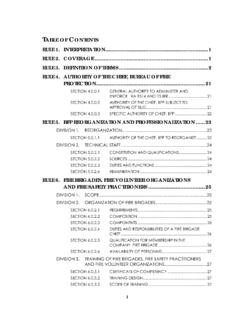Transcription of The ANSI Z358.1-2014 Plumbed & Portable Eyewash Standard
1 The ansi & Portable Eyewash StandardEnvironmental Health & Safety University Health Services, Suite 002 Telephone: (405) 744-7241 Fax: (405) 744-7148 Revision Date: September 2016 What is the ansi Eyewash Standard ?The Occupational Safety and Health Administration Standard 29 CFR states: Where the eyes or body of any person may be exposed to injurious corrosive materials, suitable facilities for quick drenching or flushing of the eyes and body shall be provided within the work area for immediate emergency use. Because the terminology suitable facilities is quite vague, the ansi Standard was adopted in an effort to clearly define suitable facilities. The ansi Standard was initially adopted in 1981 and has undergone numerous revisions, with ansi being the most of EyewashesThere are two types of eyewashes that are deemed acceptable by the ansi Standard : Plumbed eyewashes and self-contained, gravity-fed Portable eyewashes.
2 Plumbed Eyewash stations are connected to a potable water source while Portable Eyewash stations have their own flushing fluid. The fluid used by a Portable Eyewash station can consist of potable water treated with a bacteriostatic solution or a cartridge with sterile saline solution (It is recommended that Portable Eyewash stations use a buffered, sterile saline solution due to its similarity to human tears and the physiological pH of the eye). Regardless of the type of Eyewash station used, the compliance requirements are the same. Compliance RequirementsA quick overview of the compliance requirements are listed below (they are the same for both Plumbed and Portable Eyewash stations).: The flowrate of the water/solution must be gallons per minute for 15 minutes. The pressure of the flow of the water/solution must be 30 pounds per square inch.
3 The actuator valve must be hands-free and must remain open until manually closed. The peak of the water flow pattern must be 33 to 53 inches from the surface on which the user stands and must be a minimum of 6 inches from the wall or nearest obstruction. The Eyewash fluid must flush both eyes simultaneously. The Eyewash fluid must be tepid. This is defined by ansi as 60 100 degrees Fahrenheit. Eyewash stations should be within 10 seconds of the hazard. This is defined by ansi to be approximately 55 feet. The Eyewash stations should be activated weekly to verify operation and ensure that flushing fluid is available. Self-contained, Portable Eyewash stationPlumbed Eyewash stationEnvironmental Health & Safety University Health Services, Suite 002 Telephone: (405) 744-7241 Fax: (405) 744-7148 Revision Date: September 2016 Are your eyewashes compliant with ansi Use this checklist: The ansi Standard has the following criteria for eyewashes: A controlled, low velocity flow rinses both eyes and is not harmful to the user.
4 The flow is high enough to allow the user to hold their eyes open while rinsing. Covers are attached to the spray heads to minimize airborne contaminants. These covers must be able to be removed by the water flow. The Eyewash unit has a flow rate of gallons per minute for 15 minutes. The water pattern created by the Eyewash should be position between 33 and 53 inches from the floor and at least 6 inches from the wall or nearest obstruction. The Eyewash valve should be hands-free and activate in one second or less. The valve actuator is easily located and quickly accessible to the user. The Eyewash unit washes both eyes simultaneously. The Eyewash should be situated within 10 seconds (55 feet) from the hazard or adjacent to caustics. It should be easy to identify the Eyewash station via signage and adequate lighting.
5 The temperature of the water should be tepid (between 60 and 100 degrees Fahrenheit). All employees should be instructed on the use and location of the Eyewash station. All Eyewash units should be activated or checked weekly and be inspected for compliance TrainingAll personnel who could be exposed to a chemical splash, or other eye hazard, should be trained to use the available Eyewash . The training topics should include the location of the Eyewash , how to use the Eyewash , and how to assist someone who needs to use the Eyewash . A good training practice is to blindfold the employee and have them walk to the Eyewash station. This practice is similar to an actual eye incident because personnel typically close their eyes when injured. Eye Protection and SafetyThe Centers for Disease Control and Prevention (CDC) states that 2,000 US workers have a job-related injury that requires medical attention and treatment.
6 The majority of these injuries occur from objects or small particles striking the eye, however, many incidents are caused by chemicals or common cleaning products. Although accidents happen, many incidents can be prevented by taking the appropriate safety precautions (the American Society of Safety Engineers states that 90 percent of eye injuries are preventable ). Appropriate safety precautions include wearing the correct eye protection, knowing the location and how to use the emergency Eyewash , and reading the SDS for each possible chemical hazard. Any Questions?Any questions about the new ansi Standard or questions about your emergency eyewashes can be directed to Lab Safety at EHS: (405) ansi & Portable Eyewash Standar






